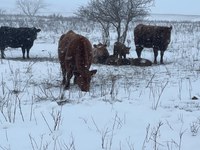Winter weather requires major shift in cattle management
(Click the image below to view a high-resolution image that can be downloaded)
“Winter weather is here and storms are in the forecast,” says Zac Carlson, NDSU Extension beef cattle specialist. “This storm may bring heavy snow, cold temperatures and raging winds. Cattle feel the effects of extreme weather, and producers need to make sure the provided feed is meeting the energy and protein needs of the cow herd.”
Carlson recommends, “When doing feeding chores, make sure you are paying close attention to the body condition and fat cover on the cow herd. Cows that are too thin will suffer the most as fat is the insulation factor for the cow. Snowfall cover on the backs of cows will not melt quickly on cows with good insulation.”
Substantial snowfall is forecast and drifting can make open area access to feed and water difficult. Farmers and ranchers need to move cattle to areas that provide some protection from the wind as soon as possible. Waterers need attention. Ice build-up around automatic waterers is common and injuries can occur if they are competing for limited water space.
The November storm brought some needed moisture. However, the snow is compacted, and there will not be sufficient water available to meet the needs for cattle, especially cows on high roughage, high dry matter rations. The specialists recommend spreading feed out, so all cattle have access and providing extra feed during this time.
If cows are being maintained on relatively poor-quality feeds or temperatures get too extreme, altering the amount of feed will not meet the increased energy requirements for the cattle. Feeds of higher nutrient quality (more energy dense) must be included to achieve the needed level of nutrition during cold spells.
“This is not the time to be feeding low quality forages (low protein),” says Dr. Gerald Stokka, NDSU Extension veterinarian and livestock stewardship specialist. “With lack of sufficient water or lack of watering space and cold weather, cattle will try to eat more and impactions (digestive blockage) can occur.”
If farmers and ranchers are grazing cover crop or some type of grazing system, snow depth can severely restrict the animals’ ability to consume enough forage to meet their needs. These animals will need to be supplied with extra harvested forage.
Some feeds can be dangerous if hungry cattle are allowed full access. For example, grains and high-quality alfalfa can cause digestive disturbances or bloat if cattle consume too much.
“Consider supplying enough feed for several days to cattle in cases when additional snowfall and drifting are forecast and could restrict cattle’s access to feed for a period of time,” says Stokka.
In feedlot settings, cattle may back off feed for a day or several days, so farmers and ranchers must make sure to get them eating pre-storm rations. Limit feeding or feeding smaller amounts several times a day can avoid digestive disturbances in feedlot cattle. Another option is to reduce dietary energy for a period of time by adding more roughage, then following that with a gradual transition back to high-energy finishing rations.
“Take steps to ensure cattle are out of the wind,” says Stokka. “If natural windbreaks (trees, draws, etc.) are available, take advantage of them for feeding sites. If no natural windbreaks exist, producers will need to take steps to make permanent or portable windbreaks to protect cattle from the wind. Portable panels are good options when maintaining cattle in relatively open country.”
Bedding may not always be necessary for wintering cow herds, but in cases where cattle are wet, it is a must. Bedding helps keep cattle dry and provides insulation from the cold ground. It also can provide a reprieve for cattle that have been standing or walking for several days after storms.
Extension specialists also recommend ranchers watch their cattle closely for health conditions that arise from exposure to winter weather. Hypothermia and frostbite may be apparent immediately, but cattle can be at risk for pneumonia and other conditions for several weeks after severe events. Farmers and ranchers should talk with their veterinarian to establish treatment plans for any anticipated or observed illness.
Farmers and ranchers need to protect themselves from the weather as well. Make sure the cattle are fed and have protection from the wind before the storm breaks or the temperatures plummet. Take a few moments to make sure you are dressed appropriately before heading out the door. Communicate with neighbors and offer assistance if needed.
For assistance with ration formulation, feeding recommendations or other winter management concerns, contact your county NDSU Extension office at https://www.ndsu.edu/agriculture/extension/county-extension-offices.
For additional information related to winter storm management of cattle, visit ndsu.ag/cattleandcold.
NDSU Agriculture Communication – Dec. 9, 2022
Source: Gerald Stokka, 701-231-5082, gerald.stokka@ndsu.edu
Source: Zac Carlson, 701-231-1884, zachary.e.carlson@ndsu.edu
Editor: Kelli Anderson, 701-231-6136, kelli.c.anderson@ndsu.edu


